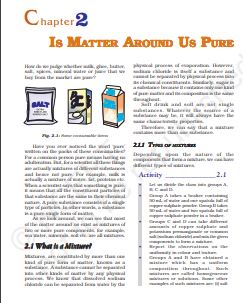‘NCERT Solutions for Class 9 Science Chapter 2‘ PDF Quick download link is given at the bottom of this article. You can see the PDF demo, size of the PDF, page numbers, and direct download Free PDF of ‘Ncert Class 9 Science Chapter 2 Exercise Solution’ using the download button.
NCERT Class 9 Science Textbook Chapter 2 With Answer PDF Free Download

Chapter 2: Is Matter Around Us Pure
2.1 What is a Mixture?
Mixtures are constituted by more than one kind of pure form of matter, known as a substance.
A substance cannot be separated into other kinds of matter by any physical process. We know that dissolved sodium chloride can be separated from water
2.2 What is a Solution?
A solution is a homogeneous mixture of two or more substances. You come across various
types of solutions in your daily life.
Lemonade, soda water, etc. are all examples of solutions. Usually, we think of a solution as a liquid that contains either a solid, liquid, or a gas dissolved in it.
But, we can also have solid solutions (alloys) and gaseous solutions (air). In a solution, there is homogeneity at the particle level. For example, lemonade tastes the same throughout.
This shows that particles of sugar or salt are evenly distributed in the solution.
A solution has a solvent and a solute as its components. The component of the solution that dissolves the other component in it (usually the component present in a larger amount) is called the solvent.
The component of the solution that is dissolved in the solvent (usually present in lesser quantity) is called the solute.
Examples:
(i) A solution of sugar in water is a solid in liquid solution. In this solution, sugar is the solute and water is the solvent.
(ii) A solution of iodine in alcohol known as ‘tincture of iodine’, has iodine (solid) as the solute and alcohol (liquid) as the solvent.
(iii) Aerated drinks like soda water etc., are gas in liquid solutions. These contain carbon dioxide (gas) as solute and water (liquid) as solvent.
(iv) Air is a mixture of gas in gas. Air is a homogeneous mixture of a number of gases. Its two main constituents are: oxygen (21%) and nitrogen (78%). The other gases are present in very small
quantities.
Properties of a solution
• A solution is a homogeneous mixture.
• The particles of a solution are smaller than 1 nm (10-9 metre) in diameter. So, they cannot be seen by naked eyes.
• Because of very small particle size, they do not scatter a beam of light passing through the solution. So, the path of light is not visible in a solution.
• The solute particles cannot be separated from the mixture by the process of filtration. The solute particles do not settle down when left undisturbed, that is, a solution is stable.
| Author | NCERT |
| Language | English |
| No. of Pages | 17 |
| PDF Size | 4.2 MB |
| Category | Science |
| Source/Credits | ncert.nic.in |
NCERT Solutions Class 9 Science Chapter 2 Is Matter Around Us Pure
Explain the following giving examples.
(a) Saturated solution
(b) Pure substance
(c) Colloid
(d) suspension
Solution:
(a) Saturated solution: It is that state in a solution at a specific temperature when a solvent is no more soluble without an increase in the temperature. Example: Excess carbon leaves off as bubbles from a carbonated water solution saturated with carbon.
(b) Pure substance: A substance is said to be pure when it comprises of only one kind of molecules, atoms or compounds without adulteration with any other substance or any divergence in the structural arrangement. Example: Sulphur, diamonds
(c) Colloid: A Colloid is an intermediate between solution and suspension. It has particles of various sizes, that ranges between 2 to 1000 nanometers. Colloids can be distinguished from solutions using the Tyndall effect. Tyndall effect is defined as the scattering of light (light beam) through a colloidal solution. Example: Milk, gelatin.
(d) Suspension: It is a heterogeneous mixture that comprises of solute particles that are insoluble but are suspended in the medium. These particles that are suspended are not microscopic but visible to bare eyes and are large enough (usually larger than a micrometre) to undergo sedimentation.
What is meant by a substance?
Answer:
SubstanceA substance is a matter which consists of a single type of particles and has specific
properties. For example tin, sulphur, pure sugar (sucrose) etc
How would you confirm that a colourless liquid given to you is pure water?
Solution:
We can confirm if a colourless liquid is pure by setting it to boil. If it boils at 100°C it is said to be pure. But if there is a decrease or increase in the boiling point, we infer that water has added impurities hence not pure.
Which of the following materials fall into the category of “pure substance”?
(a)Ice
(b)Milk
(c)Iron
(d)Hydrochloric acid
(e)Calcium oxide
(f)Mercury
(g)Brick
(e)Wood
(f)Air.
Solution:
Following substances from the above-mentioned list are pure substances:
- Iron
- Ice
- Hydrochloric acid
- Calcium oxide
- Mercury
Identify the solutions among the following mixtures.
(a) Soil
(b) Sea water
(c) Air
(d) Coal
(e) Soda water
Solution:
The following are the solutions from the above-mentioned list of mixture:
- Sea water
- Air
- Soda water
Which of the following will show the “Tyndall effect”?
(a) Salt solution
(b) Milk
(c) Copper sulphate solution
(d) Starch solution.
Solution:
Tyndall effect is exhibited by only milk and starch solution from the above-mentioned list of solutions.
Is Matter Around Us Pure NCERT Textbook With Solutions PDF Free Download
